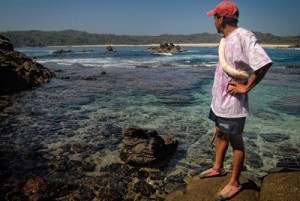Fourteen indigenous Mixtec men, working along 30 miles of remote, rocky coastline in the Mexican Pacific, carry on an ancient tradition of dyeing cotton purple using the ink of small sea mollusks. They are last traditional people on Earth who carry on this legendary practice.
These men, from the village of Pinotepa de Don Luis, in the state of Oaxaca, are continuing a tradition passed down to them through the centuries by their forefathers. Each October, for untold generations, shell dyers from Pinotepa have headed down the coast in groups of five or six, walking 8 days, until coming to the rocky shoreline where these dye producing mollusks live among the crevices. The Mixtec call this animal Tucohoyi Tixinda. Western scientists have named it Purpura pansa.
Certain mollusks have been used in many parts of the world to obtain a purple dye. Perhaps the most fabled was Tyrolean Purple obtained from Murex in the Mediterranean. In the Mediterranean, Japan and elsewhere, the mollusks had to be killed to obtain the dye. Given that purple-dyed garments where so highly coveted, this inevitably led to the extreme reduction or extinction of these species. Purpura pansa, however, does not need to be killed to extract the dye. If one applies gentle pressure to the foot of the mollusk the ink is released. This milky white liquid is dabbed onto a skein of cotton thread that the dyer carries wrapped around his forearm. The dyer then replaces the shell in a protected crevice where it will reattach and continue with its mollusk business.
It is this simple fact, combined with the Mixtec dyers’ deep understanding of the ways of Purpura panza, which have kept this species alive to this day. The dyers know, for example, that Purpura will regenerate its ink within one moon cycle, and so return to a given cove once every 28 days or so during the dyeing season. They only milk large, mature shells. They know that the mollusks mate in the summer and therefore only dye from October until March.
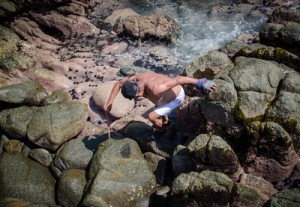
The Purpura panza shell fish live in the tidal zone of the Pacific Ocean and can only be reached during low tide.
The dyeing is no fast process. It takes about 400 shells to dye one 12 oz. skein of cotton. And the dyers can only work about three hours a day. This is dictated by the tides. Purpura lives on rocks in the inter-tidal zone, so the shell dyers must work during low tide to reach them. These days a dyer is lucky to finish one skein a day. That amount was higher before 1981.
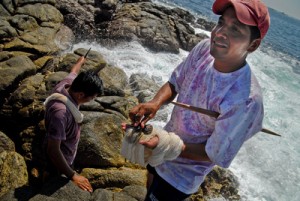
The Mixtec dyers use mangrove root sticks to pry the shell fish off the rock. Once they have been milked they are carefully put back where they re-adhere to the rock.
From 1981-84 a Japanese corporation called Imperial Purple Inc. nearly stripped the Oaxacan coastline of Purpura. They hired local fishermen to use Purpura to dye cotton and silk thread that they used to create cloth for high end furniture coverings. These fishermen knew nothing of the ancient Mixtec conservation methods. They harvested the shells year round, using any size shell they found and replacing them on the rocks arbitrarily, if at all. In this four-year period the Purpura population was drastically reduced. (Turok, et al. 1988).
Finding their old dyeing grounds depleted or barren, the dyers of Pinotepa organized and presented a formal complaint to various government agencies and the president of the Republic, stating, basically, that the shells and the dyers lifeways were being destroyed. Studies where done, Imperial Purple Inc. was sent elsewhere and, in 1988, Purpura became protected, with its harvested being permitted only by certain individuals. (Turok, et al. 1988).
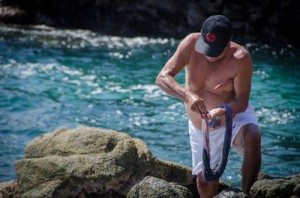
The foot of the shell fish is pressed causing it to release the ink. One moon cycle later the mollusk will have fully recharged its ink.
The ink of Purpura is actually a whitish color. It is a narcotic that paralyzes the nervous system of marine invertebrates and is used by Purpura both for protection and to immobilize its prey. However, when placed on cotton or other fibers and exposed to light and oxygen the ink photo-oxidizes, turning from a cream color to a turquoise blue and finally to a very stable purple. (Turok, et al. 1988).
When the dyers have dyed some 10-15 skeins they return to the village. With the coastal highway this is no longer an 8 day walk, but rather a 5-hour bus ride.
Historically there were several villages along the coast of Oaxaca that dyed with Purpura and it was traded as far north as Acapulco and south to the ports of Nicoya in Costa Rica (also historically an important dyeing region) and even as far as the port of Guayaquil in Ecuador (Turok, et al. 1988). Now it is only the men of Pinotepa de Don Luis who continue this practice, and the purple cotton it is not traded much further than their home village, where the dyers sell it to the women weavers.
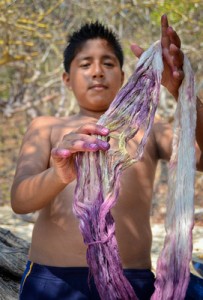
There are only 14 dyers left. But perhaps the sons and grandsons of the dyers will be inspired to take up the trade.
They in turn weave it into garments. The most impressive of which is the posahuanco, which is a kind of wrap dress that is worn by coastal Mixtec women. The posahuanco is woven with bands of color that are composed of dark, indigo-dyed blue cotton, Purpura-dyed cotton and red silk that was historically dyed with cochineal but is now dyed with synthetics. With times changing and these dresses being very expensive, few younger women wear them any more. They chose either posahuancos woven with sythentic-dyed cottons or, more commonly, they wear Western style dresses.
Still, the Purpura-dyed posahuancos are looked on with great respect, and there are women who still follow the age-old custom of being married in a special posahuanco; a genuine posahuanco not only confers status, the Purple is associated with fertility. It is also customary to be buried in a shell-dyed posahuanco (Turok, et al. 1988). In response to the disappearing demand for the traditional wraps, some weavers in Pinotepa have begun making blouses, pillowcases and other items incorporating the purple cotton with hopes of selling them to a more mainstream public. They have had limited success in selling these. The principle problem being that, aside from the remoteness of Pinotepa de Don Luis and therefore limited access to potential clients, the purple cotton is necessarily expensive. This drives up the price of whatever item is made with it. Most consumers don’t appreciate the purple and therefore aren’t willing to pay the higher price.
With the shells now recognized as a national treasure and protected by the federal government, there is hope for their survival, and they are slowly recovering from the exploitation by the Japanese company. In much greater danger are the cultural elements of the coastal Mixtec people, who have valued and cared for Purpura pansa. This, the last of the great shell dyeing traditions, is not likely to disappear because the shells have been driven to extinction, but rather because it is cheaper, and more fashionable, to buy a polyester dress.
Reference: Marta Turok, et al. 1988. El Caracol Púrpura. Culturas Populares: Mexico City, Federal Dist., Mexico.
Eric Mindling lives in Oaxaca Mexico, organizing one of a kind tours into the world of traditional weavers and dyers in Indigenous Mexico. This Winter his company, Traditions Mexico, is offering two trips that include shell-fish dyeing:
Fiber Arts of the Oaxacan Coast, Jan 24-Feb 1, 2014
Murex, Silk and Threaded Flowers, March 5-13, 2014
For more info see www.traditionsmexico.com or email traditionsmexico(at)yahoo.com
